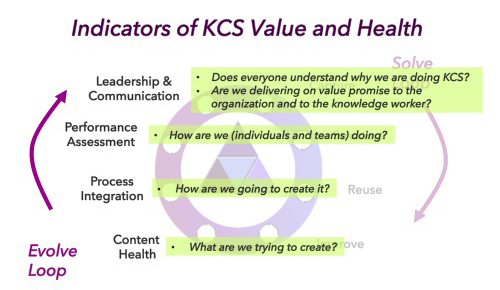The Evolve Loop
Evolve Loop Overview
The Evolve Loop reflects on and learns from a collection of Solve Loop tasks and associated knowledge articles. It is the organizational-level processes which analyze the patterns that emerge for a collection of tasks and knowledge use. It only works if each task is done correctly. The Solve Loop and Evolve Loop are interdependent: each enables the other.
The Evolve Loop is the systemic view that provides:
- Definition of the higher level organizational practices and techniques
- Definition of the measures and indicators of health for each practice
- Continuous improvement processes for the:
- Solve Loop and the infrastructure that supports the Solve Loop behaviors (functionality and tool integration)
- Knowledge base through creation or refinement of high-value articles based on patterns of article reuse and self-service activity
- Self-service experience and success
- Identification of improvement opportunities based on knowledge worker activity and knowledge reuse.
- Root cause analysis to identify high impact improvements to the products, documentation, business processes, and policies
The Solve Loop and Evolve Loop together create a system that is self-correcting. The Evolve Loop depends on people doing the right things in the Solve Loop. It is the aggregate of lots of events, each handled correctly, that enables the Evolve Loop analysis. By analyzing the collection of events and related knowledge articles over time, the Evolve Loop identifies areas for improvement in the Solve Loop. Perhaps most importantly, the Evolve Loop identifies opportunities for improvement to the business. The root cause analysis done in the Evolve Loop can drive improvements to products, services, processes and policies. These improvements are based on the collective experiences of the knowledge worker and of those we serve.
KCS Value and Health Indicators
Each of the Evolve Loop practices includes a set of indicators that together can be used to assess the value KCS is creating for the organization. These indicators can also be used to assess the health of the KCS Practices. The definition and use of these indicators will be discussed in more detail under each Practice section. Here is a summary of the key indicators by Practice:
- Content Health
- Content Standard Checklist (formerly Article Quality Index or AQI) - adherence to the content standard
- Assessing the value of articles - indicators of value: reuse, reference and value of the collection of articles
- Search effectiveness: a combination of search technology, structure, context, and environment statements
- Process Integration
- Process Adherence Review (PAR) - adherence to the Solve Loop workflow
- Technology - Technology or Infrastructure functionality, integration, and response time
- Performance Assessment
- Value Creation Indicators (VCI) - performance assessment for individuals and teams
- Leadership & Communication
- Communication Effectiveness Indicators (CEI) - understanding and buy-in to KCS across the organization
- Organizational Value Indicators - realization of the KCS benefits for the organization and delivering on the WIIFM (What's In It For Me) for each of the stakeholders

Content is King... and Leadership is Required
In KCS, content is king. We will start the Evolve Loop discussion with Content Health: what are we trying to create? Then we will discuss the Process Integration practices: how are we going to create good content? From there we move to a discussion on Performance Assessment: how do we measure how we are doing? Performance Assessment is about individual and team value creation. Last, but certainly not least, we will discuss the critical elements of Leadership & Communication: how do we get people, at all levels of the organization, to understand and buy in to KCS? It is leadership's responsibility to create an environment where people are willing and eager to change their behavior; it is the behavior change that KCS requires of both the knowledge worker and the leadership of the organization that creates the profound benefits.
The Evolve Loop Practices

